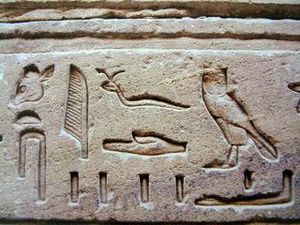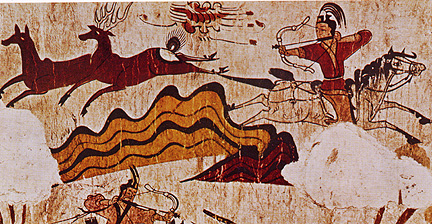Article by Slater Smith
Very recently, I got into a discussion on which careers are beneficial to society and which are not. At some point, an individual said that art has absolutely no purpose to the world, giving no explanation as to why. I was immediately startled. How could anyone not know the value of fine art? After a day or two of thinking, I realized that very little painters, sculptors, and other craftsmen are ever referred to outside of an art history or appreciation course and how many students even take the time to participate in such classes? I does not make sense to study the French Revolution with without studying Jacques-Louis David, nor is it logical to speak of religion without the Sistine Chapel being mentioned. In this article, I would like to explain the various ways artists have shaped today’s world.
The cavemen were the first to manipulate pigments to create art. Though they were uncivilized, cavemen somehow made representations of the natural world in a way that was full of energy and life. Painting on stones and rocks was a normal thing to do. Small figurines were carved of women in a multitude of shapes and sizes, possibly referring to fertility or prehistoric deities. Animals were a popular subject. The decorated the walls with bold lines and limited perspective. Cavemen saw the intrigue of art. It is an instinctive part of man, yet it seems many have become too “sophisticated” to recognize the basic human desires.
Architecture is also an ancient art, though I know many people lacking proper appreciation toward it. Our ancient ancestors often built temples to worship their gods and goddess or to praise their kings. Their buildings often had beautifully constructed columns and sculptures with reliefs carved into the walls. The Egyptians built massive pyramids to honor their deceased Pharaohs. The Pantheon in Rome became an ideal basis for many structures around the world, like the White House and many universities. Medieval churches are known for being covered with luminous mosaics. Even the roofs we sleep under might seem simple at a glance, but hold years of wisdom in them.
 Art was also one of the earliest forms of communication. The earliest written languages were pictorial, not being composed of the letters used today. The hieroglyphics in Egypt are a primary example of this. They used symbols in the world around them to write, such as hawks, the sun, and chisels. It took thousands of years to convert over to the Latin alphabet that the majority of languages use today. Chinese and Japanese, on the other hand, continue to use alterations of the “pictures” used by archaic languages. Calligraphy and, arguably, the typeface I use to write this, are forms of art that society uses to spread their ideas and information.
Art was also one of the earliest forms of communication. The earliest written languages were pictorial, not being composed of the letters used today. The hieroglyphics in Egypt are a primary example of this. They used symbols in the world around them to write, such as hawks, the sun, and chisels. It took thousands of years to convert over to the Latin alphabet that the majority of languages use today. Chinese and Japanese, on the other hand, continue to use alterations of the “pictures” used by archaic languages. Calligraphy and, arguably, the typeface I use to write this, are forms of art that society uses to spread their ideas and information.
Let us not forget that healthcare would not be the same with artists. Yes, our doctors of today might not be as advanced without art! The painters of the Renaissance struggled to achieve idealism and perfection in their works. To learn figure drawing and portraiture, they did anatomical studies by dissecting the corpses of criminals, which, at the time, was considered sacrilege and punishable by death. Nevertheless, they continued their research. One of the greatest of these painters was Leonardo da Vinci. To draw the figure, one needs only know the bones, muscles, and skin, but da Vinci took it a step further. He dissected over thirty bodies, learning of organ systems, blood vessels, described diseases, and so on. That’s not even including his studies on optics, aerodynamics, and his numerous inventions. Artists were the only people who cared about the inner working of the body, as opposed to the “doctors” who lived off of superstitions and inaccurate conclusions drawn by the Greeks and Romans.
Ever since freedom of speech was issued, art has, still is, and always will be a messenger to the people. Christianity benefited from the sculptures and frescoes of Michelangelo. During the French Revolution, Jacques-Louis David painted works like “The Death of Marat” to show his fervent support toward the war.

Later, Eugène Delacroix’s “Liberty Leading the People” expresses his want for freedom, while maintaining the cruel losses inflicted by rebellion. The Women’s Rights movement used female painters, like Artemisia Gentileschi, as a reference to show the women are equal to men. In these modern times, artists continue to spread propaganda on political issues through social media.
With all of this, I still must wonder how could anyone not know the value of fine art. We find both it and its influences no matter which way we look. There was a time when a Master was a great man, known throughout his country – even his continent! In present times, the best of craftsman are not household names. You have to dig and dig to name a few, but none of your peers would recognize the titles. Perhaps this is the result of contemporary art, with its flat paintings and foul sculptures that give art a bad representation. Perhaps it is the cartoons on television the make people think that art is silly and childish. Perhaps it is the idea of natural talent that shuns art away from our lives. Whatever the reason, I would just like to say that art is a gift to the world that deserves the appreciation that it does not get.





